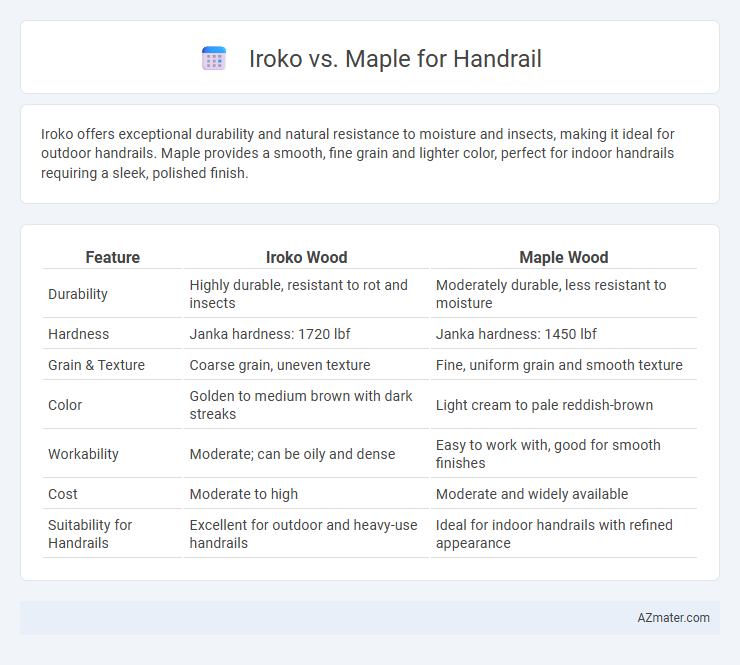Iroko offers exceptional durability and natural resistance to moisture and insects, making it ideal for outdoor handrails. Maple provides a smooth, fine grain and lighter color, perfect for indoor handrails requiring a sleek, polished finish.
Table of Comparison
| Feature | Iroko Wood | Maple Wood |
|---|---|---|
| Durability | Highly durable, resistant to rot and insects | Moderately durable, less resistant to moisture |
| Hardness | Janka hardness: 1720 lbf | Janka hardness: 1450 lbf |
| Grain & Texture | Coarse grain, uneven texture | Fine, uniform grain and smooth texture |
| Color | Golden to medium brown with dark streaks | Light cream to pale reddish-brown |
| Workability | Moderate; can be oily and dense | Easy to work with, good for smooth finishes |
| Cost | Moderate to high | Moderate and widely available |
| Suitability for Handrails | Excellent for outdoor and heavy-use handrails | Ideal for indoor handrails with refined appearance |
Introduction to Iroko and Maple for Handrails
Iroko is a highly durable hardwood known for its strength, resistance to rot, and rich golden-brown color, making it a popular choice for handrails in both indoor and outdoor settings. Maple, favored for its fine, uniform grain and light creamy color, offers excellent hardness and smooth finish ideal for intricate handrail designs. Both woods provide longevity and aesthetic appeal, but Iroko's natural oils make it more resistant to moisture compared to the denser, yet less water-resistant maple.
Key Characteristics of Iroko Wood
Iroko wood is renowned for its durability, high resistance to rot, and natural oils that make it ideal for handrails exposed to outdoor elements. Its golden to medium brown color with a coarse texture offers both aesthetic appeal and strength, outperforming many hardwoods in wear resistance. Unlike Maple, which has a lighter color and smoother grain, Iroko provides superior weather resistance and longevity, making it a preferred choice for long-lasting handrail installations.
Key Characteristics of Maple Wood
Maple wood for handrails is prized for its exceptional hardness and durability, making it resistant to dents and wear in high-traffic areas. Its fine, uniform grain and smooth texture allow for precise machining and a polished finish, enhancing aesthetic appeal. Compared to Iroko, maple offers a lighter color palette and superior stability in indoor environments, reducing the likelihood of warping or shrinking over time.
Durability and Longevity Comparison
Iroko wood offers exceptional durability with natural resistance to decay, insects, and moisture, making it highly suitable for handrails exposed to outdoor elements. Maple, while strong and dense, generally requires protective finishes to prevent wear and environmental damage, especially in high-traffic areas. Over time, Iroko's inherent toughness ensures greater longevity and minimal maintenance compared to maple, which may need more frequent refinishing to maintain appearance and structural integrity.
Aesthetic Differences: Color and Grain
Iroko handrails exhibit a warm golden to medium brown color with occasional darker streaks, providing a rich, exotic appearance that deepens over time. Maple handrails showcase a lighter, creamy to pale yellow hue with a subtle, consistent grain pattern, offering a clean and modern aesthetic. The striking contrast between Iroko's bold grain and color variation and Maple's smooth, uniform texture allows designers to tailor handrail choices to either standout warmth or minimalist elegance.
Workability and Installation Ease
Iroko offers excellent workability with its medium hardness and straight grain, allowing for smooth cutting, drilling, and shaping without excessive wear on tools. Maple, known for its density and fine, even grain, provides a very smooth finish but can be harder to work with due to its stiffness, requiring sharper tools and more effort during installation. The ease of installation favors Iroko when quick adjustments and fastening are needed, while Maple demands careful handling to avoid splitting and ensure precise fitting in handrail applications.
Maintenance Requirements for Iroko vs Maple
Iroko handrails require less maintenance than maple due to their natural oil content, which provides resistance to rot and insect damage, reducing the need for frequent sealing or treatment. Maple handrails are more prone to wear and may demand regular sanding, sealing, and refinishing to maintain their appearance and durability. Choosing Iroko minimizes upkeep efforts, making it ideal for high-traffic or outdoor applications where maintenance frequency is a concern.
Cost Considerations: Iroko vs Maple
Iroko handrails typically cost more than maple due to their tropical hardwood status and greater durability, making them a long-term investment for outdoor use. Maple offers a more budget-friendly option with a lower initial price but may require more maintenance over time because of its softer grain. Considering both upfront cost and longevity, Iroko provides better value in high-traffic or exterior environments, while maple suits indoor settings with controlled conditions.
Environmental Impact and Sustainability
Iroko wood, sourced from West African tropical forests, offers a durable and naturally rot-resistant handrail option with moderate environmental impact due to concerns over deforestation and slower growth rates. Maple wood, primarily harvested from sustainably managed North American forests, presents a more eco-friendly choice with faster renewability and certification availability, reducing carbon footprint and promoting responsible forestry practices. Choosing maple supports sustainability efforts better, while iroko requires careful sourcing to minimize environmental degradation.
Best Applications: Choosing the Right Wood for Your Handrail
Iroko wood is ideal for outdoor handrails due to its high durability, natural resistance to decay, and weathering, making it perfect for decks and exterior staircases. Maple offers a smooth grain, hardness, and fine finish, which suits indoor handrails requiring a polished appearance and strength for high-traffic areas. Selecting Iroko or Maple depends on environment and aesthetic needs, ensuring longevity and safety in handrail applications.

Infographic: Iroko vs Maple for Handrail
 azmater.com
azmater.com